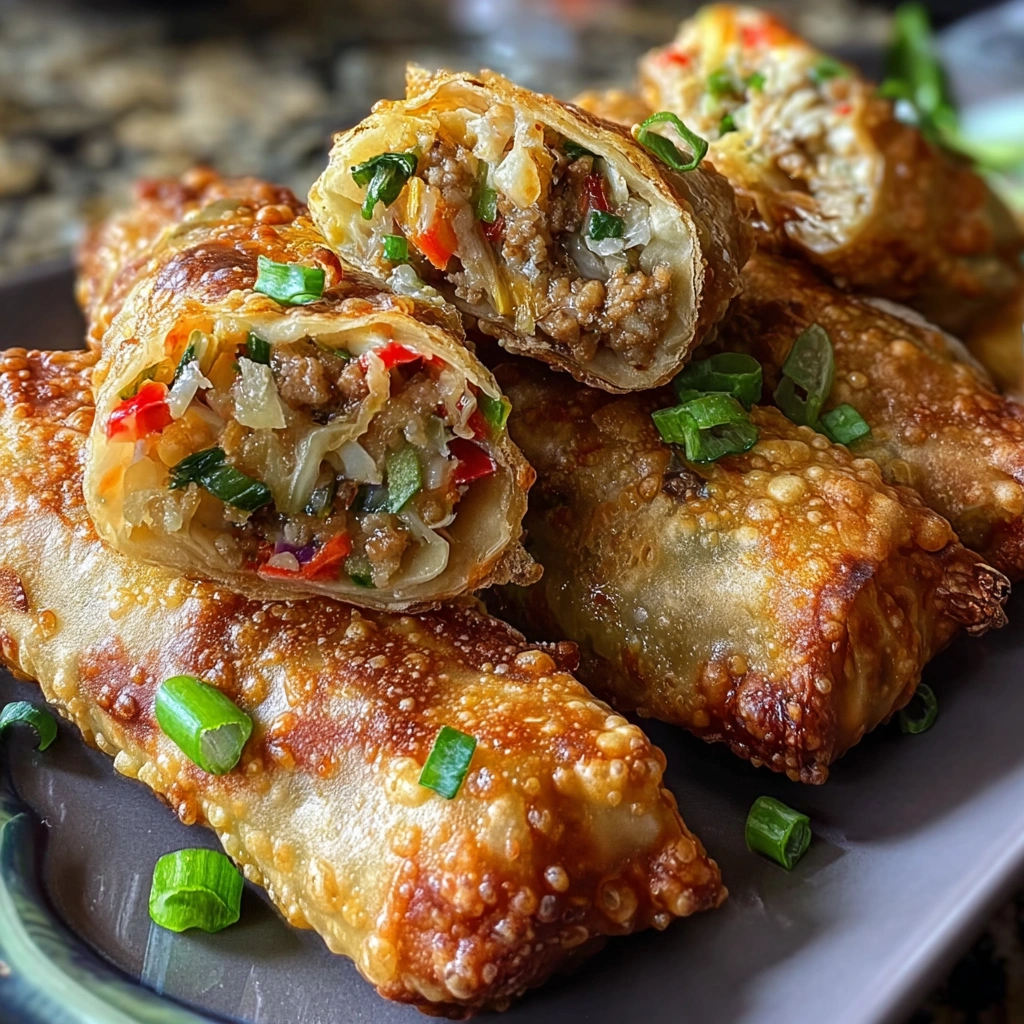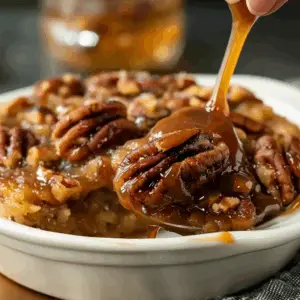Homemade egg rolls are the kind of comfort food that effortlessly bridges the gap between a quick appetizer and a satisfying main dish. These crispy, golden delights have long been a staple of Asian-American cuisine, often found at takeout counters and buffet tables. But nothing compares to making them at home—where you control the ingredients, flavor, and level of crispiness.
One of the major benefits of creating egg rolls from scratch is how customizable they are. Whether you’re craving the classic chicken version or prefer vegetarian or spicy alternatives, the possibilities are endless. Plus, when you make them yourself, you’re skipping preservatives and unnecessary oils often found in frozen or takeout versions.
If you’re curious about the history of egg rolls, you’ll find that they originated as an American-Chinese dish, a twist on the more delicate spring roll (source). These hearty appetizers are traditionally made by wrapping a savory filling—often cabbage, meat, and spices—inside a wheat flour wrapper, then deep frying them until crisp. You can even experiment with healthier approaches like using an air fryer or baking instead, many of which can be found in this excellent Pinterest board on homemade air fryer recipes.
🛒 Ingredients breakdown for homemade egg rolls
Making homemade chicken egg rolls starts with fresh, simple ingredients that you can find at almost any grocery store. The magic is in how these basic components combine into something truly delicious.
🧂 Essential ingredients:
-
10–12 egg roll wrappers: Look for these in the refrigerated section of most grocery stores near the tofu or salad kits. These are crucial to getting that crispy outer shell. While spring roll wrappers can be an alternative, they are thinner and result in a different texture (learn more).
-
2 cups shredded cooked chicken: Using rotisserie chicken is a smart shortcut that adds flavor and saves time (see more).
-
3 cups tri-color coleslaw mix: This mix typically includes green cabbage, purple cabbage, and shredded carrots—making it colorful, nutritious, and super convenient. You can learn more about the benefits of cabbage here.
-
1 tablespoon olive oil: Used to lightly sauté the coleslaw mix before wrapping.
-
Salt and pepper to taste: A simple way to bring all the flavors together.
-
Vegetable oil for frying: Choose a neutral oil with a high smoke point. Read about suitable oils here.
-
Water (for sealing wrappers): Helps ensure your egg rolls stay sealed while frying.
🥢 Optional flavor boosters:
-
Minced garlic or ginger
-
Soy sauce or low-sodium tamari
-
Chopped green onions
-
A splash of sesame oil (for aroma)
This ingredient list not only forms the base of your chicken egg roll recipe, but also opens the door for many creative variations. You’ll find plenty of ideas in this Pinterest collection of coleslaw recipes, which can help you experiment with different vegetable combinations.
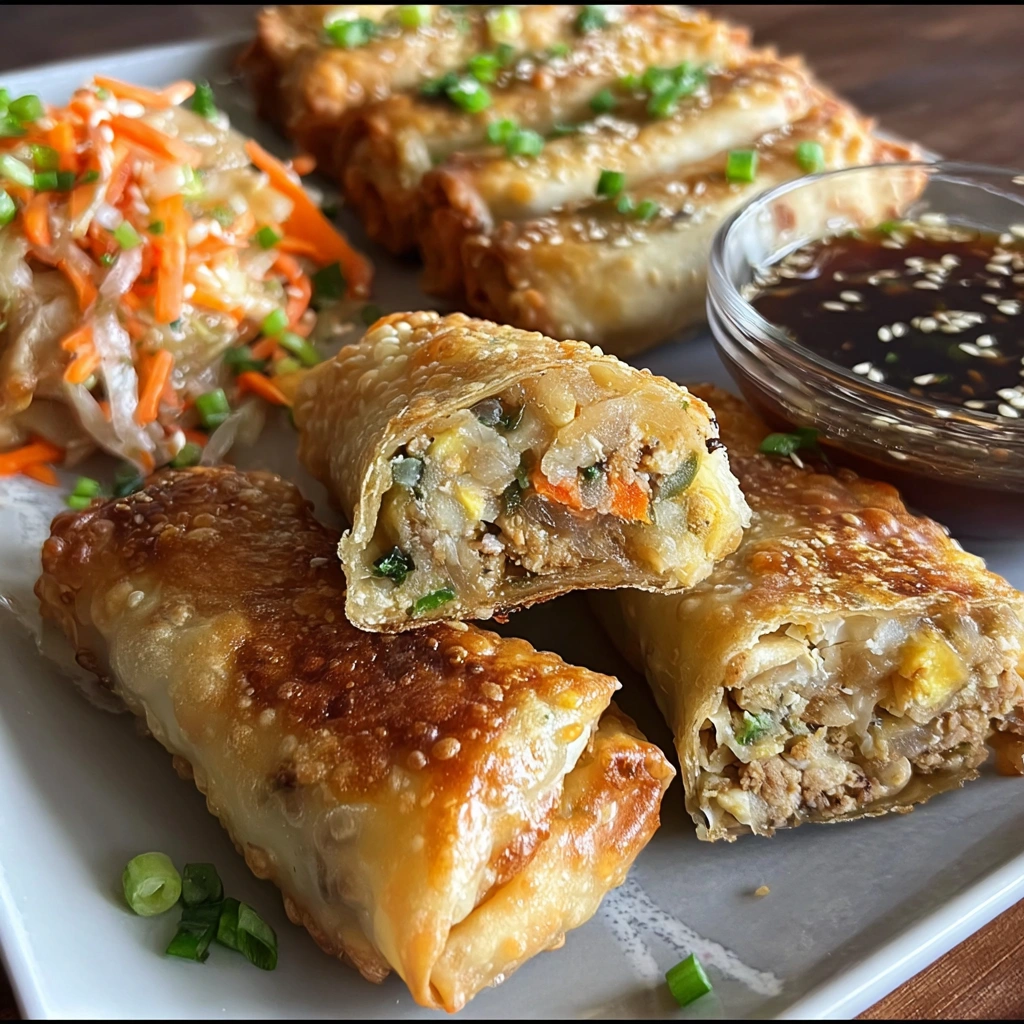
🔪 Step-by-step instructions for perfect egg rolls
Creating homemade egg rolls is a rewarding process that becomes easier with practice. Here’s a foolproof guide that ensures you get crunchy, flavorful rolls every time.
🍳 Preparing the filling:
-
Heat 1 tablespoon of olive oil in a large skillet over medium heat.
-
Add 3 cups of tri-color coleslaw mix and sauté for 3–4 minutes until slightly softened.
-
Stir in 2 cups of shredded rotisserie chicken. Cook for an additional 2–3 minutes.
-
Season the mixture with salt and pepper. You can also add a dash of soy sauce or sesame oil if desired.
-
Let the filling cool slightly to make wrapping easier.
🧻 Assembling the egg rolls:
-
Lay out an egg roll wrapper in a diamond shape on a clean surface.
-
Spoon about 1/4 to 1/3 cup of the filling horizontally across the center.
-
Fold the bottom corner up over the filling, then fold in the left and right sides toward the center.
-
Roll tightly upwards, sealing the top edge with a bit of water to secure it.
🍳 Frying the egg rolls:
-
Heat 3/4 inch of vegetable oil in a skillet to between 350°F and 375°F.
-
Fry the egg rolls in small batches, turning them as needed to ensure all sides are golden brown.
-
Transfer to paper towels to drain excess oil.
This process, while straightforward, benefits from attention to detail—particularly when it comes to oil temperature and wrapping technique. For safety tips and methods, explore this article on deep frying.
For those looking for dipping options, check out this Pinterest roundup of dipping sauces that complement egg rolls perfectly.
🧠 Tips for perfect egg rolls every time
Even seasoned cooks sometimes struggle with achieving that perfect crispy egg roll. Here are expert-approved tips that ensure delicious, professional-quality results:
-
Don’t overfill the wrapper: Too much filling will make it hard to roll and increase the chance of breakage.
-
Seal tightly: Use a dab of water along the edge to seal. Loose rolls will unravel while frying.
-
Avoid soggy filling: Let your cabbage cook off moisture and allow the mixture to cool before wrapping.
-
Maintain oil temperature: Use a thermometer to keep the oil between 350°F and 375°F. Lower temps absorb oil, making the rolls greasy.
-
Fry in batches: Overcrowding the pan lowers the oil temp and leads to uneven cooking.
Taking these precautions ensures your homemade chicken egg rolls come out crisp, golden, and satisfying every time.
🌶️ Flavor variations and alternative fillings
The beauty of homemade egg rolls lies in their versatility. Once you’ve mastered the base recipe, consider experimenting with these delicious variations:
-
Vegetarian egg rolls: Use mushrooms, tofu, or glass noodles as a meat-free substitute.
-
Turkey bacon & cabbage: Add crispy turkey bacon strips to the filling for a smoky twist.
-
Spicy egg rolls: Mix in diced jalapeños or add sriracha to your filling for heat.
-
Shrimp egg rolls: Swap out chicken for finely chopped shrimp and pair with scallions.
-
Asian fusion egg rolls: Try Thai peanut chicken or Korean bulgogi-inspired beef.
-
Gluten-free: Use rice paper or specialty gluten-free wrappers.
-
Baked or air-fried egg rolls: Cut down on oil and calories while still keeping a crunchy texture. Explore air fryer inspiration from this Pinterest page.
This range of fillings not only caters to various dietary preferences but also elevates your egg rolls from simple appetizers to gourmet creations.
🍽️ Serving suggestions and dipping sauces
Serving your egg rolls with the right sides and dips turns them into a complete culinary experience.
🥢 Popular dipping sauces:
-
Sweet chili sauce
-
Soy sauce or tamari
-
Garlic sriracha mayo
-
Hoisin or peanut dipping sauce
-
Plum sauce or teriyaki glaze
For inspiration, browse this Pinterest board of Asian appetizers, which includes both sauces and pairings.
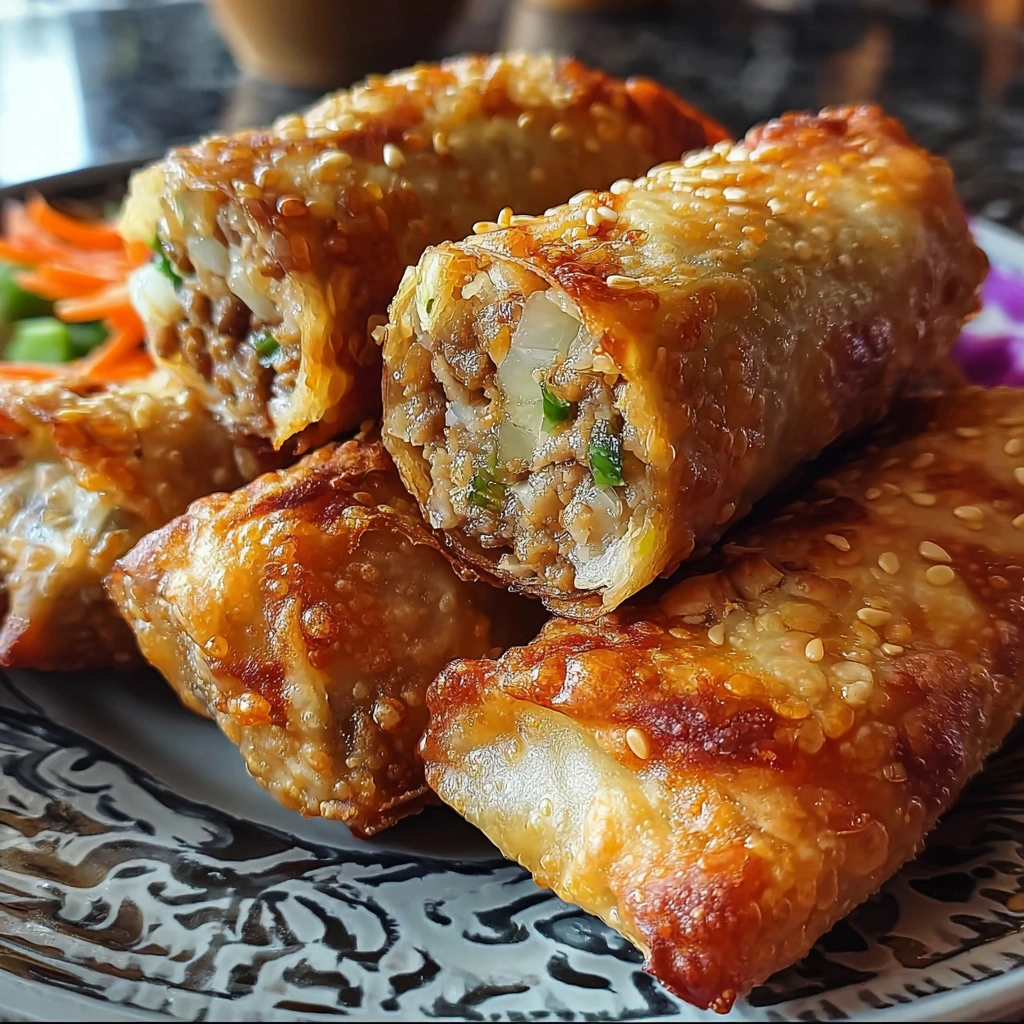
🍚 Ideal side dishes:
-
Fried rice or steamed jasmine rice
-
Stir-fried bok choy or green beans
-
Asian cucumber salad
-
Wonton or miso soup
🍃 Garnish and presentation:
-
Sprinkle with sesame seeds
-
Add chopped green onions
-
Serve on a platter with dipping bowls
This attention to detail elevates your homemade egg rolls into a restaurant-style meal perfect for dinner parties or casual snacks.
🧊 Storing and reheating tips
Don’t worry if you’ve made too many—egg rolls store and reheat well when handled properly.
🧊 How to store:
-
Refrigerate cooked egg rolls for up to 4 days in an airtight container.
-
Freeze cooked or uncooked egg rolls individually wrapped in foil or plastic wrap, then place in a freezer bag.
-
Freeze for up to 3 months.
🔁 How to reheat:
-
Oven: Bake at 375°F for 10–12 minutes until crispy.
-
Air fryer: 350°F for 5–7 minutes.
-
Microwave: Use sparingly—it softens the wrapper. Try 30-second intervals if needed.
Proper storage and reheating mean you can always have crispy egg rolls on hand without compromising quality.
🥗 Nutrition and health considerations
While traditional fried egg rolls aren’t exactly health food, there are plenty of ways to make them lighter without sacrificing taste.
🍃 Nutritional breakdown (per egg roll):
-
Calories: ~150–200
-
Protein: ~10g
-
Carbs: ~15–18g
-
Fat: ~7–9g (depending on frying method)
🥗 Healthier swaps:
-
Air fry or bake instead of deep frying
-
Use lean meats like chicken or turkey
-
Skip high-sodium sauces
-
Add more veggies to the filling
-
Try low-carb or gluten-free wrappers
-
Swap pork bacon for turkey bacon for a lighter, halal-friendly option
Learning how to make egg rolls at home gives you complete control over ingredients and portion size, helping you enjoy this favorite dish more mindfully.
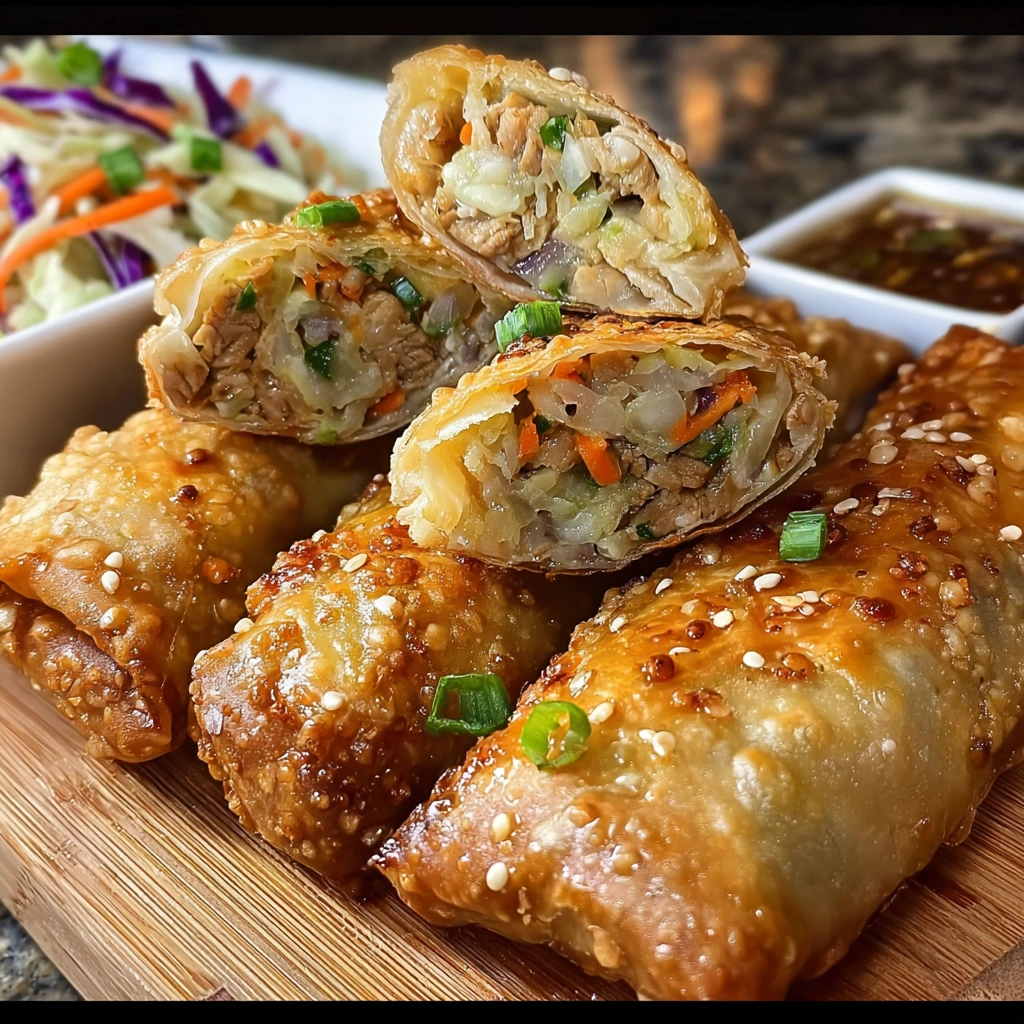
❓ FAQs – people also ask
What is typically in an egg roll?
Traditional egg rolls include shredded cabbage, carrots, and some form of protein like pork or chicken, all wrapped in a flour-based wrapper and fried.
Can egg rolls be made in advance?
Yes! You can assemble and refrigerate or freeze them before frying. Just be sure to seal them tightly and separate with parchment to prevent sticking.
What is the best way to keep egg rolls crispy?
Drain on paper towels immediately after frying and keep warm in an oven at 200°F if you’re not serving them right away.
Are egg rolls Chinese or American?
They are an American-Chinese invention, inspired by spring rolls but adapted with a thicker wrapper and heartier filling (learn more here).
Can I bake egg rolls instead of frying them?
Absolutely. Brush them with oil and bake at 400°F for 12–15 minutes, flipping halfway through for even crisping.
Can you use spring roll wrappers instead?
You can, but expect a thinner, crispier texture. Spring rolls use rice-based wrappers versus the flour-based ones in egg rolls.
How do you seal egg rolls without egg wash?
Water works perfectly—just wet the edges of the wrapper before rolling to seal them tight.
Can egg rolls be made vegetarian or vegan?
Yes! Use tofu, mushrooms, or beans, and swap out the wrappers for vegan-friendly versions.
🏁 Conclusion
Making homemade egg rolls is more than just following a recipe—it’s about bringing people together with food that’s crisp, warm, and full of flavor. With a few simple ingredients, the right techniques, and some creative twists, you can turn this humble appetizer into a show-stopping meal. Whether you’re frying, baking, or air-frying, the versatility of egg rolls makes them a must-try for any home cook.
Now that you’ve mastered the basics, don’t be afraid to explore bold new fillings, sauces, and serving styles. Share your creations with friends, freeze some for later, and enjoy the satisfaction of knowing you made them from scratch.
PrintHomemade Egg Rolls
These crispy homemade chicken egg rolls are filled with tender rotisserie chicken and a colorful tri-color coleslaw mix, all wrapped in a golden, crunchy shell. Perfect for parties, meal prep, or a fun dinner at home. Make them fried, baked, or air-fried—your choice!
- Prep Time: 15 minutes
- Cook Time: 15 minutes
- Total Time: 30 minutes
- Yield: 10–12 egg rolls 1x
- Category: Appetizer / Snack
- Method: Frying
- Cuisine: American
Ingredients
For the filling:
2 cups shredded cooked chicken (rotisserie recommended)
3 cups tri-color coleslaw mix (green cabbage, purple cabbage, carrots)
1 tablespoon olive oil
½ teaspoon salt (or to taste)
¼ teaspoon black pepper (or to taste)
For assembling:
10–12 egg roll wrappers
Small bowl of water (for sealing)
For frying:
Vegetable oil, enough to fill skillet about ¾ inch deep
Instructions
1. Prepare the filling:
-
Heat 1 tbsp olive oil in a large skillet over medium heat.
-
Add 3 cups of tri-color coleslaw mix and sauté for 3–4 minutes, until slightly tender.
-
Stir in 2 cups shredded rotisserie chicken.
-
Season with salt and pepper, cooking for another 2–3 minutes.
-
Remove from heat and let the filling cool slightly before wrapping.
2. Assemble the egg rolls:
-
Lay an egg roll wrapper in a diamond shape on a flat surface.
-
Place about ¼ to ⅓ cup of filling horizontally across the center.
-
Fold the bottom corner up over the filling.
-
Fold in both sides, then roll up tightly.
-
Seal the top edge with a dab of water to close securely.
-
Repeat with remaining wrappers and filling.
3. Fry the egg rolls:
-
Heat about ¾ inch of vegetable oil in a skillet to 350°F–375°F.
-
Fry 3–4 egg rolls at a time for 2–3 minutes per side, turning until golden brown.
-
Remove and drain on paper towels.
-
Repeat with remaining egg rolls.
Notes
-
Don’t overfill the wrappers—it makes rolling and sealing harder.
-
Cool the filling before wrapping to prevent sogginess.
-
Use gluten-free or low-carb wrappers for dietary adaptations.
-
These egg rolls freeze beautifully before or after frying—perfect for meal prep!
-
Swap chicken for tofu, mushrooms, or turkey bacon for different flavors.
